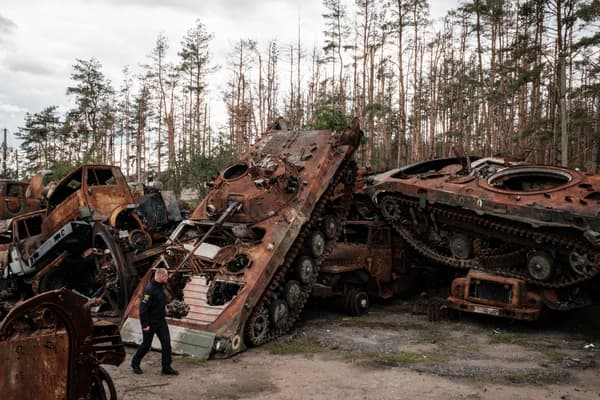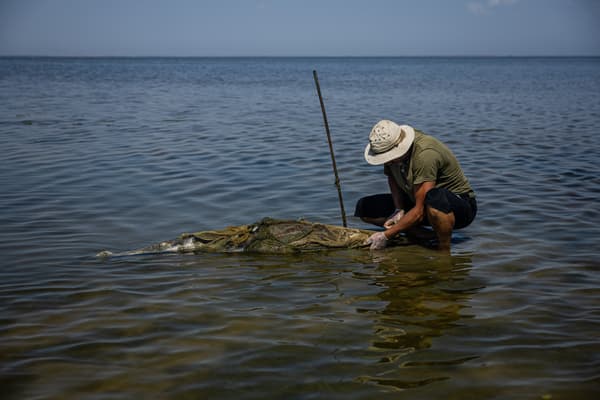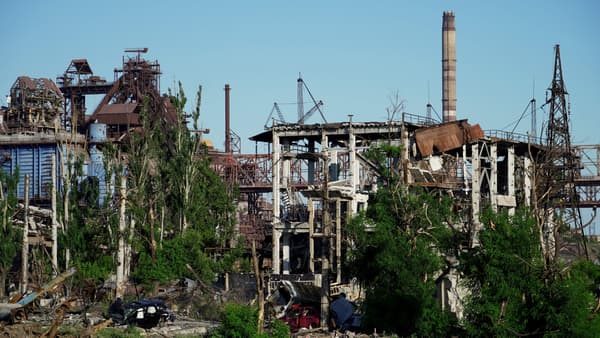Fires in refineries or chemical plants, destruction of dams, minefields or even the corpses of Russian tanks scattered on the ground… The war in Ukraine is not only causing a humanitarian catastrophe: it is also an ecological disaster.
The UN issued the alert this summer. “Preliminary monitoring of the conflict in Ukraine shows significant consequences for urban and rural environments that could leave the country and the region with a toxic legacy for generations to come,” warned the United Nations Environment Program (UNEP) in a press release published in early July.
The institution says it has already identified “thousands of potential incidents of air, water and soil pollution and ecosystem degradation, including risks to neighboring countries.”
Heavy metals, asbestos…
Military attacks cause many infrastructure fires but also plants and leave behind a large amount of residue: for example, fragments of shells and their heavy metals or debris from buildings sometimes contaminated with asbestos. There are also abandoned or damaged military vehicles. The Ukrainian government has identified more than 15,000 on its territory, just for the Russian army.

“The pollution it generates is pollution linked mainly to the deposit that these vehicles may have had, possibly fuel oil projections,” explains Adrien Estève, a military strategy researcher, interviewed by BFMTV.com.
“You have metal, you have a set of components that will disintegrate and permanently contaminate certain parts of the Ukrainian territory.”
The Soviet industrial heritage makes the situation even more critical: Ukraine is one of the European countries with the most factories linked to heavy industries such as metallurgy or petrochemicals. And since the start of the conflict, these sites have been the target of numerous Russian attacks, as this map by the NGO Zoï Environment shows.
According to their census, more than 250 industrial facilities have been affected since the beginning of the war. “Every time you come across a factory that even produces basic necessities, you also expose yourself to all kinds of pollution that will undoubtedly reach the groundwater,” says Adrien Estève, also the author of War and ecology. “So we are in a contamination that unfortunately will last for a few years.”
serious consequences
The consequences are already heavy for ecosystems. According to estimates by the Ukrainian authorities, about 900 natural protected areas in Ukraine have been affected by Russian military activities, which represents approximately 30% of all protected areas in the country.
Some species are even directly affected by war. On the Black Sea coast, nearly 3,000 cetaceans have been stranded since the start of the conflict. According to biologists, the animals were disturbed by sonars from warships.

But what is most worrying is the contamination of rivers and soil, which could compromise the habitability of large areas of Ukraine. In early April, for example, Russian rockets destroyed chemical deposits in the Ternopil region in the west of the country. Shortly after, environmental services inspectors recorded ammonia levels 163 times higher than standards in the Ikva River.
Therefore, contamination, in the long term, could compromise access to drinking water, but also to farmland in certain regions. According to the Ukrainian Environmental Protection Group (UNCF), almost a third of Ukrainian crops may become unusable after the war.
“From the moment you have unexploded shells that will notably end up in the fields, they will necessarily pollute and even make the work of farmers dangerous for several generations,” Adrien Estève points out. “We still see it in northern France today, we still have shells from the 1914 war.”
Environmental war crimes?
The extent of this environmental damage remains difficult to measure at the moment. Today, the Ukrainian authorities and NGOs are doing their best to document the damage day after day.
“We use what materials we can, such as satellite images, to draw conclusions about the impact of war on the environment,” says UNCG director Oleiksy Vasiluk.
“And we are really shocked by the number of territories affected by the war. It is very difficult to give exact figures because at the moment it is not possible for us to go there.”
This data collection is essential to amassing evidence that could one day allow Russia to be sued in national or even international courts. There is an international legal arsenal that recognizes environmental crimes as war crimes, but it is currently difficult to apply.
The International Criminal Court thus considers as a war crime “the act of intentionally directing an attack knowing that it will incidentally cause (…) extensive, long-lasting and serious damage to the natural environment that would be manifestly excessive in relative terms.” to the general, concrete and direct military advantage expected”. A benefit that can be difficult to define.

“Take chemical plants like Azovstal, for example,” says Marie-Ange Schellekens, a researcher in environmental law. “If there are fighters inside, it becomes a military target. But the resulting chemical spills may be disproportionate to the number of fighters inside.”
With the risks linked to attacks on nuclear power plants like the one in Zaporizhia, the international community remains very vigilant. A delegation from the International Atomic Energy Agency (IAEA) went there to assess the possible damage, particularly ecological.
Source: BFM TV

